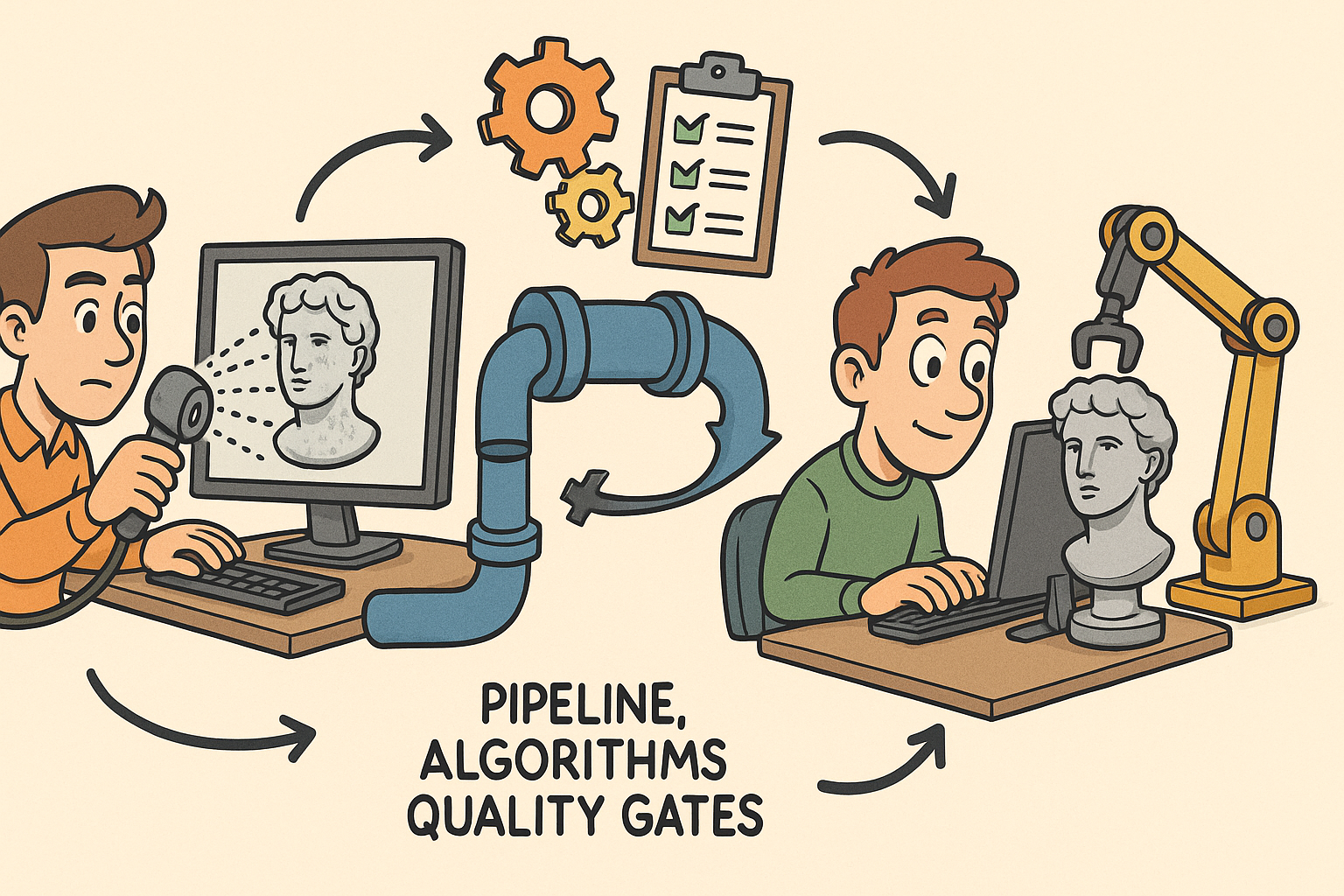Your Cart is Empty
Customer Testimonials
-
"Great customer service. The folks at Novedge were super helpful in navigating a somewhat complicated order including software upgrades and serial numbers in various stages of inactivity. They were friendly and helpful throughout the process.."
Ruben Ruckmark
"Quick & very helpful. We have been using Novedge for years and are very happy with their quick service when we need to make a purchase and excellent support resolving any issues."
Will Woodson
"Scott is the best. He reminds me about subscriptions dates, guides me in the correct direction for updates. He always responds promptly to me. He is literally the reason I continue to work with Novedge and will do so in the future."
Edward Mchugh
"Calvin Lok is “the man”. After my purchase of Sketchup 2021, he called me and provided step-by-step instructions to ease me through difficulties I was having with the setup of my new software."
Mike Borzage
Design Software History: The Evolution of Civil Engineering Design Software: From Manual Drafting to Advanced Digital Solutions
August 06, 2025 8 min read


Setting the Stage for Civil Engineering Design Software
The journey of civil engineering design software is rooted in a long and storied history that spans from the era of manual drafting to the present-day realm of advanced digital design. In the early days of construction and civil planning, engineers relied on traditional drafting methods, which involved hand-drawing detailed blueprints and using physical tools like T-squares, compasses, and set squares. The transition from a predominantly manual approach to a more automated environment was driven by the need to increase precision, manage complexity, and improve project turnaround times. During this period, the primary challenge was the accuracy and consistency required for large-scale engineering projects, which often involved extensive labor and human error. As computing machinery started to evolve, organizations and researchers saw the potential to invent systems that could build upon these manual techniques, thereby providing engineers with digital tools that mimicked the efficiency of handcraft.
Historical Context and Early Applications
Early computing approaches in civil engineering were characterized by fundamental algorithms programmed on massive mainframe computers. Researchers and engineers began to experiment with rudimentary computer-aided design applications, which were primarily used for calculations and simulations rather than real-time design drafting. During the 1960s and 1970s, the limitations of both software and hardware meant that the user experience was rudimentary, relying on command-line inputs and slow graphical displays. Despite these constraints, a few groundbreaking pioneers began to push the boundaries of design automation. This period saw the emergence of early prototypes that integrated basic drawing commands with automated calculation features, marking the first steps toward a more holistic digital design experience. Notably, these innovative methods enabled engineers to verify design parameters quickly, while also laying the groundwork for later, more sophisticated systems.
Manual Drafting Techniques and the Birth of Innovation
It is essential to understand that prior to the digital revolution, civil engineering was intimately tied to manual drafting techniques. Engineering firms maintained extensive archives of hand-drawn plans that reflected both the skill of the draftsmen and the limitations imposed by the medium. The precision of drawn lines, the careful calculation of angles, and the reliance on locally available measurement tools were all indicative of an era that prized meticulous attention to detail. The advent of early computing methods represented a significant paradigm shift. Key innovators of the time recognized the potential of integrating computational logic with design protocols, marking the inception of what would eventually mature into civil engineering design software. These advancements were supported by early software systems that combined the fundamental principles of geometry with computational logic to allow for more robust planning and simulation. The adoption of these systems by forward-thinking engineers signified the start of a transformation that would pave the way for the digital revolution in civil engineering.
Milestone Innovations and Technological Breakthroughs
The trajectory of design software in civil engineering experienced several important inflection points, each marked by groundbreaking technological advancements and innovative design processes. One of the most significant breakthroughs was the development of foundational CAD systems that initially focused on 2D drafting, but swiftly evolved into powerful 3D modeling environments. These early systems provided engineers with the ability to visualize complex structural designs in a digital space, thereby enhancing accuracy and lowering the risk of error in calculations. Over time, these systems integrated more innovative concepts such as parametric modeling and finite element analysis, which not only amplified the efficiency of design workflows but also enabled engineers to simulate and predict the performance of large-scale civil projects even before construction began. The leap from manual to digital drafting was not merely incremental; it symbolized an era of rapid innovation where refined computational techniques began to directly influence the industrial processes underlying civil engineering.
Evolution of CAD and the Integration of 3D Modeling
The evolution of CAD technology, particularly in transforming from 2D drafting tools to robust 3D modeling environments, marked an essential turning point for civil engineers. Early proponents of computer-aided design included companies and innovators who saw the potential to digitally replicate the detailed work of manual drafting while introducing dynamic, changeable models that could be iteratively improved. This evolution was characterized by the incorporation of user-friendly interfaces, enabling broader adoption among professionals. Furthermore, the integration of 3D visualization inherently improved the ability to interact with models from multiple perspectives, exposing potential design flaws and enhancing spatial comprehension. Early CAD systems, developed by industry trailblazers such as Autodesk, laid the foundational principles that not only streamlined the design process but also fostered a culture of innovation that championed the need for adaptable, real-time modeling solutions.
Parametric Modeling, Finite Element Analysis, and GIS Integration
Advancements such as parametric modeling and finite element analysis redefined the scope of design software within the realm of civil engineering. Parametric modeling introduced a new layer of dynamic functionality by allowing design elements to be modulated with variable parameters, thereby enabling rapid adaptations to design changes; this brought about a substantial improvement in precision and flexibility. Additionally, finite element analysis provided engineers with robust tools for performing intricate structural simulations, ensuring that models accurately portrayed potential stresses and failure points under varying loads. Equally significant was the integration of GIS technologies, which bridged the gap between digital terrain analysis and design implementation, ultimately enhancing the planning and execution of large-scale civil infrastructure projects. Vital contributors, including major companies like Bentley Systems and Autodesk, played prominent roles in these breakthroughs. Their persistent drive to improve design parameters and optimize digital workflows allowed for the creation of versatile systems that have withstood the test of time, revolutionizing conventional civil engineering practices.
The following bullet list encapsulates some of the key technological advancements in civil engineering design software:
- 2D to 3D Transition: The foundational shift that enabled accurate spatial modeling and better visualization of structures.
- Parametric Modeling: Introduction of adaptable design elements which provide robust design flexibility.
- Finite Element Analysis (FEA): Implementation of simulation techniques crucial for understanding load and stress behaviors.
- GIS Integration: Merging geographical data with design software to enhance planning and project execution.
These advancements not only improved the overall workflow in the civil engineering design process but also set a benchmark for the continuous evolution of design methodologies. The incorporation of these features signified a considerable leap forward, providing engineers with an enriched toolbox of capabilities that could be applied to increasingly complex projects. As engineers navigated the challenges associated with modern construction projects, these technologies offered the means to develop designs that were more flexible, resilient, and precisely tailored to meet dynamic project requirements. It is through these cumulative innovations that civil engineering design software has grown from modest beginnings to become an indispensable part of contemporary engineering practice.
Transformation of Civil Engineering Practice and Applications
The evolution of design software has always been interwoven with the transformation of civil engineering practices themselves. Over the decades, the progressive layers of technological improvements led to far more comprehensive and integrative design workflows. The cumulative impact was vast, altering how engineers approached project design, analysis, and implementation. Traditionally, structural planning posed real challenges due to the complexity of manually calculating load-bearing capacities and material strengths. However, with the arrival of sophisticated simulation tools integrated into CAD systems, engineers could now execute detailed stress tests, simulate environmental factors, and explore alternative design strategies long before any physical work commenced. The digital transition allowed for the fusion of computational precision with creative engineering practice, which provided a pragmatic alternative to the conventional trial-and-error approaches seen in earlier decades.
How Technological Advancements Revolutionized Projects
One of the most noticeable shifts brought by modern design software was the radical improvement in efficiency and accuracy during project planning phases. Through the integration of advanced systems capable of conducting complex geospatial analyses alongside structural simulations, civil engineers were suddenly empowered to tackle projects that previously would have been deemed too intricate or risky. The design of extensive infrastructure networks, massive bridges, and urban planning ventures became more streamlined as these digital tools enabled the visualization and analysis of multiple variables simultaneously. The parallel use of simulation tools meant that potential problems could be identified and mitigated early in the design process, thereby reducing cost overruns and project delays. In addition, the iterative capabilities of digital software allowed for rapid prototyping of multiple design alternatives, thus fostering innovation. This evolution has had a monumental influence on civil engineering, distinguishing modern practices from traditional methods by emphasizing data-driven decision-making, accuracy, and targeted foresight.
Bullet Points Reflecting Practical Software Applications
Key applications of the modern software revolution in civil engineering can be outlined as follows:
- Infrastructure Design: Advanced CAD systems facilitate detailed planning and simulation of bridges, tunnels, and highways with unprecedented precision.
- Urban Planning: Integration with GIS enables complex spatial analysis, crucial for planning urban layouts that consider both environmental and social factors.
- Transportation Networks: Digital modeling supports the design of intricate transportation hubs and transit systems, ensuring safety and efficiency.
- Hydraulic and Environmental Engineering: Simulation tools allow for precise calculations of water flow, erosion, and other environmental factors, ensuring sustainable design practices.
These aspects highlight the dynamic interplay between the technological capabilities of design software and the ever-changing demands of civil engineering. As project scales have increased, so too have the expectations placed on software solutions to not only support traditional workflows, but also to offer predictive insights and real-time analytical feedback. Through the broad adoption of integrated design systems, many civil projects now benefit from adaptable models that can be refined continuously, reflecting both new scientific insights and changing regulatory frameworks. The transformation has thus been twofold: the software itself has grown in sophistication, while the professional practices that utilize these tools have become more holistic, data-centric, and adaptive. This mutual evolution continues to define the modern landscape of civil engineering, paving the way for future innovations that will undoubtedly build on these historic milestones.
Conclusion: Lessons from the Past and Future Horizons
In retrospect, the evolution of civil engineering design software is not just a tale of technological triumph but also a story of human ingenuity and the relentless quest for efficiency. The historical journey, starting with the transition from manual drafting to early computing solutions and progressing through significant innovations such as 3D CAD, parametric modeling, and finite element analysis, has fundamentally redefined how civil engineering challenges are approached and solved. The progression encapsulates decades of continuous improvement, marking a shift from labor-intensive processes to intelligent, simulation-driven design methodologies. This transformation has imbued the discipline with enhanced accuracy, improved project management, and an overwhelming capacity to simulate complex conditions well before a project is physically realized. As the field continues to evolve, each historical milestone serves as a blueprint for future innovations, guiding current practices and anticipating the emerging needs of a rapidly changing global infrastructure landscape.
Reflecting on Historical Milestones
The enduring impact of early innovations remains evident in every modern civil engineering project. Every technological breakthrough—from the inception of basic CAD systems to the integration of advanced simulation modules—has contributed essential elements to the robust digital toolkit available today. This legacy underscores the importance of embracing technological change and continuously seeking improvements. It is clear that the lessons drawn from past innovations have prepared the groundwork for tackling contemporary challenges. Furthermore, the evolution of these digital systems is demonstrative of an industry-wide commitment to precision, efficiency, and safety. The historical milestones impart vital insights into the balance between human creativity and machine precision. These insights have not only shaped current engineering practices, but they also continue to guide research and development teams as they explore emerging technologies in design software.
Future Directions and Emerging Technologies
Looking ahead, the future of civil engineering design software is set to be defined by the integration of cutting-edge technologies such as artificial intelligence, machine learning, and cloud-based collaborative platforms. These innovations promise to further streamline design workflows, enable more robust predictive modeling, and foster global collaboration among engineers across diverse geographical regions. With an increasing emphasis on sustainability and smart infrastructure, designers are now turning to software solutions that offer real-time data processing and enhanced simulation capabilities to meet the complex demands of modern projects. The evolution of design software is therefore characterized not by a final destination, but by an ongoing process of improvement and adaptation. Lessons learned from past decades serve as a cornerstone, empowering the next generation of developers and engineers to push the frontiers of what is possible. As we embark on this exciting future, it is essential to recognize that every breakthrough builds upon the legacy of prior achievements, cementing a tradition of innovation that continues to inspire future generations.
Also in Design News

From Raw Scans to Manufacture-Ready Geometry: Pipeline, Algorithms, and Quality Gates
December 08, 2025 13 min read
Read More
Design Software History: Numerical Robustness in Geometry Kernels: History, Failure Modes, and Engineering Playbook
December 08, 2025 13 min read
Read More
Cinema 4D Tip: Reusable Cinema 4D Camera Rig Presets for Faster Shot Setup
December 08, 2025 2 min read
Read MoreSubscribe
Sign up to get the latest on sales, new releases and more …


